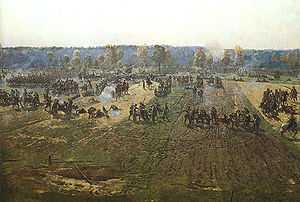Bagration flèches


The Bagration flèches (Russian: багратионовы флеши[1]) are certain historic military earthworks named after Pyotr Bagration who ordered their construction. They were the pivotal Russian strongholds on the left flank during the Battle of Borodino in 1812. Located south-west of the village of Semyonovskoye, the flèches consisted of two lunettes and one redan, which were stormed eight times in the course of the battle.[2] The flèches were constructed by infantry divisions of the 2nd Army and militiamen to give an opportunity to the artillery of firing not only to the French front, but also the flank. Five hundred men were detailed to their construction from each division, except the 27th, which sent six hundred.[2] The left work was erected by the 26th Infantry Division, the right by the 2nd Grenadier Division and the middle one by the 2nd Combined Grenadier. The construction was finished on August 25, 1812 (O.S., used by the Russians) (September 6, N.S., used by the French).
Attacks
The Bagration flèches were occupied by the 11th and the 32nd Russian Battery Companies. The left work had twelve guns, the middle one had seven and the right five.[2] Each work also had one battalion from the 2nd Combined Grenadier Division.[2] Twenty eight guns were stationed near the flèches. On August 26 / September 7, about 6 a.m., Napoleon launched the fight for the flèches according to plan. Two infantry divisions of Joseph Marie, Count Dessaix and Jean Dominique Compans, supported by 102 guns, assaulted the flèches directly.[2] The first attack was repelled by fire from the guns and Jäger infantry units.
In the second attempt, the French dragged their artillery closer to the Kamenka Brook and strengthened the troops with three extra infantry divisions from Michel Ney's corps, three from Joachim Murat's cavalry corps and additional artillery. After the attack at about 7 a.m. Compans' troops burst into the left flèche. However the storm was repelled again by Russian infantry, the Akhtyr hussars and Novorossiyan dragoons. Bagration ordered Nikolay Raevsky to move the entire line of his 7th Infantry Corps (eight battalions) to the left-flank works. During the struggle, several French generals were wounded, and Louis-Nicolas Davout received a concussion after falling from a horse killed under him.[2]
Before the third attack, Lieutenant-General Aleksandr Tuchkov was ordered to send reinforcements, the 3rd Infantry Division of Pyotr Konovnitsyn. At about 8 a.m., after a bombardment, the French stormed the flèches again, some being eliminated with canister shot. Compans' infantry retook the left flèche while Francois Roch Ledru des Essarts' troops rushed into the spaces between flèches. The offensive was repulsed by a bayonet counter-attack of soldiers of the 2nd Combined Grenadier and 27th Infantry Divisions.
At about 9 a.m. Napoleon ordered the fourth assault. The French succeeded in taking the flèches one hour later, but were driven out soon after.
During the fifth attempt, at 11 a.m., the French took the right and the left fortifications, and Tuchkov was killed. However, Konovnitsyn's division managed to counter-attack and repelled the French again.
An attempt to gain the flèches' rear through the forest failed.
After regrouping, Jean Andoche Junot's infantry gained the rear of the troops defending the flèches, but it was overthrown shortly after, and Ney's and Davout's frontal attacks were also parried.
The seventh assault was made futile by the Brest, Ryazan, Minsk and Kremenchug Infantry Regiments, while Ney's and Davout's offensives were warded off once more.
The last storming was so powerful that the Russian artillery failed to stop the French columns. Bagration ordered the infantry to counter-attack and not to wait till the French approached the flèches. The fierce combat lasted about an hour. Bagration was badly wounded and evacuated from the battlefield. From 60,000 men assembled for storming the flèches, up to 30,000 were lost. Historians [who?] have marked the slaughter as the "grave of the French infantry". This had been the biggest battle ever recorded in terms of the casualty rate, around about half the people on the field of battle ended up as casualties. The number of the dead remained the highest until the first day of the Battle of the Somme in World War 1.[2]